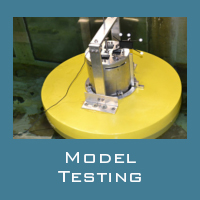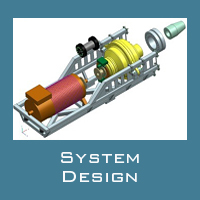The following is a short list of projects Re Vision has been involved in over the past few years. This is by no means a comprehensive list, but is a representative subset of the type of projects in which we have been involved.

Publications:
- M. Previsic, A. Karthikeyan, A. Chertok, R. Nie, D. Clabby and J. Scruggs (2016). Optimal causal control of wave energy converters in stochastic waves – Accommodating nonlinear dynamic and loss models.

Publications:
- M. Previsic, A. Karthikeyan, J. McCarthy and T. Lewis (2018). Techno-economic optimization of a deep water oscillating water column device.

Publications:
- M. Previsic, A. Karthikeyan, A. Chertok and J. Scruggs (2018). Constrained optimal control of a flap-type wave energy converter with a hydraulic power take-off and realistic loss Model.
Publications: None yet

Re Vision is developing an easy to use GIS-based scenario-modeling tool that allows users to characterize the commercial potential of a particular site or larger geographic areas. It will do so by utilizing the experience gained over the past decade in developing such scenarios for a wide range of clients.
Publications: None yet

Advanced wave prediction and concurrent online adjustment of the operating parameters (such as hydraulic system pressure and generator load) of existing wave energy conversion (WEC) devices has the potential to increase the power extracted from ocean waves by such devices by at least 200% over presently used approaches. However, commercial devices under development today still use control strategies based largely on 'slow-tuning' approaches, which result in significantly reduced wave power extraction and poor economic viability. This is largely due to two major issues: (1) the difficulty of predicting the waves encountered by a WEC system 20-40 seconds in advance, which is required to effectively implement optimal tuning strategies, and (2) the challenges associated with optimizing the control system, given various nonlinear system behaviors and constraints.
Re Vision is developing a toolbox under funding from the National Science Foundation (NSF) that will allow for the development of optimal control systems for different WEC device topologies.

Work at sea is extremely expensive; even for small inspection tasks, large vessels have to be mobilized to deploy manned intervention strategies. The cost of these operations contribute significantly to the cost of electricity from these offshore power plants, especially during the early phases of industry development.
Unmanned and remotely operated vehicle technology has made significant progress over the past five years. With funding from the US Department of Energy, Re Vision Consulting is developing an autonomous vehicle platform that can be used to carry out a range of inspection and subsea intervention tasks - reducing intervention cost for some operations by an order of magnitude. It will address critical technical barriers related to the practical operation of these vehicles in the harsh offshore environment and enable a cost-reduction pathway that is a critical component of lowering the O&M cost of marine renewable energy installations.
In collaboration with Synapse Energy Economics and under contract to the Nova Scotia Utility Board, Re Vision is developing a Feed-In Tariff (FIT) structure for commercial tidal projects in the Bay of Fundy. The proposed FIT structure is expected to spur commercial development of tidal power in one of the world’s most significant tidal resources. The scope of work includes: (1) An independent assessment of project costs and device performance at the proposed deployment site, (2) Development of a proposed FIT structure that will spur commercial development, while minimizing rate-payer cost, and (3) Refinement of FIT through a stakeholder process consisting of device developers, utilities, consumer advocates and various other stakeholders.
In 2006, Re Vision Consulting (under contract to EPRI) has identified the Minas Passage in the Bay of Fundy as a major tidal energy resource in a tidal energy collaborative effort that included a wide range of stakeholders in the US and Canada. As a direct result of these efforts, FORCE was founded to develop a tidal energy site, which houses four grid-connected births.
Based on our recommendations, theNova Scotia Utility Board approved a “declining block” Developmental Tariff in November 2013. Feed-in rates were set at $455CAD/MWh for 1MW - 5MW scale projects and $375CAD/MWh for 5MW - 10MW projects. In December 2014, four developers were approved to build out 17.5 MW of tidal power under this scheme. The decision-support documents provide cost breakdowns for deployments at these scales, which were established through an industry consultation process. Details can be found here.

RE Vision was tasked to develop a performance and extreme loads assessment software tool for a novel WEC device and use it to perform system levels optimization for a commercial client. RE Vision developed the computational model using its in-house code and validated these models using a series of wave tank tests. A significant number of design variations were investigated to optimize the system. Over 100,000 dynamic model runs were carried out on a computational cluster with 256 cores. All the structural components and dimensions were parametrically defined to allow for a fully coupled optimization process that minimizes cost of electricity while maintaining appropriate factors of safety in the structural design. Leveraging Re Vision's techno-economic modeling capabilities, optimal design configurations were identified and refined.
Publications:
- Reference Model 1 Tidal Energy: Resource, B. Polagye, Northwest National Marine Renewable Energy Center
- Marine Hydrokinetic Turbine Power-Take-Off Design for Optimal Performance and Low Impact on Cost-of-Energy, M.J. Beam, B.I. Kline, W. Straka, A.A. Fontaine, M. Lawson, Y. Li, R. Thresher, M. Previsic
- Development and Verification of a Computational Fluid Dynamics Model of a Horizontal-axis Tidal Current Turbine, M.J. Lawson, Y. Li, D.C. Sale
- Structural Design of a Horizontal-axis Tidal Current Turbine Composite Blade, G. Bir, M. Lawson, Y. Li
- Reference Model 2: ‘Rev 0′ Rotor Design, M. Barone, T. Griffith, J. Berg, SAND2011-9306
- Reference Model MHK Turbine Array Optimization Study within a Generic River System, E. Johnson, J. Barco, S. James, J. Roberts, SAND2011-9305
- Reference Inflow Characterization for River Resource Reference Model: Reference Model 2 (RM2), V.S. Neary, Oak Ridge National Laboratory

- Capital cost assessment of the technology (manufacturing, construction sub-system integration, transportation to staging site)
- Design of installation procedures and selection of appropriate equipment
- Installation cost
- Failure rate analysis of system
- Operational process development
- Operational lifecycle cost assessment
- Device performance assessment
- Economic analysis
Publications:
- The Contribution of Environmental Siting and Permitting Requirements to the Cost of Energy for Marine and Hydrokinetic Devices,
A.E. Copping, S.H. Geerlofs,
Pacific Northwest National Laboratory
- Reference Model 1 Cost Breakdown Structure for Tidal Current Device, M. Previsic, RE Vision Consulting
- Reference Model 2 Cost Breakdown Structure for River Current Device, M. Previsic, RE Vision Consulting

This study addresses the following:
(1) The theoretical, technical and practical potential for electricity generation from wave energy
(2) The present lifecycle cost profile (Capex, Opex, and Cost of Electricity) of wave energy conversion technology at a reference site in Northern California at different plant scales
(3) Cost of electricity variations as a function of deployment site, considering technical, geo-spatial and and electric grid constraints
(4) Technology cost reduction pathways
(5) Cost reduction targets at which the technology will see significant deployment within US markets, explored through a series of deployment scenarios
RE Vision Consulting, LLC (RE Vision), engaged in various analyses to establish current and future cost profiles for marine hydrokinetic (MHK) technologies, quantified the theoretical, technical and practical resource potential, performed electricity market assessments and developed deployment scenarios. RE Vision was supported in this effort by NREL analysts, who compiled resource information, performed analysis using the ReEDS[1] model to develop deployment scenarios, and developed a simplified assessment of the Alaska and Hawaii electricity markets.
Publications: Final report



Publications: None – commercial project
MHK is an emerging renewable technology sector with limited deployed capacity (about 5 MW) to date. Unlike wind and other renewable and conventional technologies, there are relatively few examples of commercial applications operating today and little publicly available cost data [installation or operation and maintenance (O&M)] for these systems. In the absence of historical cost data, engineering cost models were used to develop a set of reference cost data.
Publications:
To address this issue, RE Vision Consulting, applied a scenario-based assessment approach to the emerging hydrokinetic technology sector. The goal was to improve understanding of potential environmental and navigation impacts of these technologies and focus stakeholders on the critical issues.
Publications:
Publications: None – commercial project

Publications: None
Publications:
- Previsic, Mirko. 2006. California Ocean Wave Energy Assessment. California Energy Commission, PIER Renewable Energy Technologies Program Area. CEC-500-2006-119 California Ocean Wave Energy Assessment

A total of six river sites were selected for site assessment. After careful review, three sites were selected for conceptual level feasibility studies, the results of which are described in this report. The three sites were:
- Tanana River at Whitestone
- Yukon River at Eagle
- Kvichak River at Igiugig
Publications
Publications
- Previsic M. 2005. Methodology for Conceptual Level Design of Tidal In Stream Energy Conversion (TISEC) Power Plants. EPRI Report ID: EPRI-TP-005
- Polagye B, and Previsic M. 2006. System Level Design, Performance, Cost and Economic Assessment – Knok Arm Alaska Tidal In-Stream Power Plant. EPRI Report ID: EPRI-TP-006 AK.
- Polagye B. and Previsic M. 2006. System Level Design, Performance, Cost and Economic Assessment –Tacome Narrows Washington Tidal In-Stream Power Plant. EPRI Report ID: EPRI-TP-006 WA.
- Previsic M. 2006. System Level Design, Performance, Cost and Economic Assessment –San Francisco Tidal In-Stream Power Plant. EPRI Report ID: EPRI-TP-006-SF CA
- Previsic M. 2005. System Level Design, Performance, Cost and Economic Assessment –Massachusetts Muskeget Channel Tidal In-Stream Power Plant. EPRI Report ID; EPRI-TP-006-MA
- Previsic M. 2006. System Level Design, Performance, Cost and Economic Assessment –Maine Western Passage Tidal In-Stream Power Plant. EPRI Report ID: EPRI-TP-006-ME
- Previsic M. 2006. System Level Design, Performance, Cost and Economic Assessment –New Brunswick Head Harbor Passage Tidal In-stream Power Plant. EPRI Report ID: EPRI-TP-006-NB
- Previsic M. 2006. System Level Design, Performance, Cost and Economic Assessment – Minas Passage Nova Scotia Tidal In-Stream Power Plant. EPRI Report ID: EPRI-TP-006-NS.
Publications
- Previsic M. 2004. Economic Assessment Methodology for Offshore Wave Power Plants. EPRI Report ID: E2I-EPRI-WP0US-002 Rev4
- Previsic M. 2004. E2I EPRI Assessment Offshore Wave Energy Conversion Devices. EPRI Report ID: E2I EPRI WP-004-US-Rev1.
- Previsic M. 2004. Methodology for Conceptual Level Design of Offshore Wave Power Plants. EPRI Report ID: E2I EPRI WP-005-US
- Previsic M. 2004. System Level Design, Performance and Cost – Hawaii State Offshore Wave Power Plant. EPRI Report ID: E2I EPRI Global WP-006-HI.
- Previsic M. 2004. System Level Design, Performance and Costs – Maine State Offshore Wave Power Plant. E2I EPRI Global WP-006-ME.
- Previsic M. 2004. System Level Design, Performance and Costs – Massachusetts State Offshore Wave Power Plant. E2I Global EPRI-WP-006-MA
- Previsic M. 2004. System Level Design, Performance and Costs – Oregon State Offshore Wave Power Plant. E2I EPRI Global WP-006-OR-Rev1.
- Previsic M. 2004. System Level Design, Performance and Costs – San Francisco California Energetech Offshore Wave Power Plant. EPRI Report ID: E2I EPRI-006B-SF.
- Previsic M. 2004. System Level Design, Performance and Costs for San Francisco California Pelamis Offshore Wave Power Plant. EPRI Report ID: E2I EPRI Global-006A-SF
- Previsic M. 2009. Yakutat Conceptual Design, Performance, Cost and Economic Wave Power Feasibility Study. EPRI Report ID: EPRI-WP-006-Alaska.
- Previsic, M. 2007. California Wave Power Demonstration Project. Bridging the Gap Between the Completed Phase I Project Definition Study and the next Phase – Phase 2 Detailed Design and Permitting. EPRI Report ID: EPRI-WP-011 CA.















